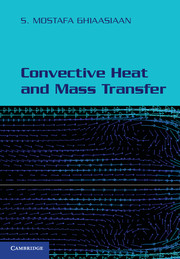Book contents
- Frontmatter
- Contents
- Preface
- Frequently Used Notation
- 1 Thermophysical and Transport Fundamentals
- 2 Boundary Layers
- 3 External Laminar Flow: Similarity Solutions for Forced Laminar Boundary Layers
- 4 Internal Laminar Flow
- 5 Integral Methods
- 6 Fundamentals of Turbulence and External Turbulent Flow
- 7 Internal Turbulent Flow
- 8 Effect of Transpiration on Friction, Heat, and Mass Transfer
- 9 Analogy Among Momentum, Heat, and Mass Transfer
- 10 Natural Convection
- 11 Mixed Convection
- 12 Turbulence Models
- 13 Flow and Heat Transfer in Miniature Flow Passages
- APPENDIX A Constitutive Relations in Polar Cylindrical and Spherical Coordinates
- APPENDIX B Mass Continuity and Newtonian Incompressible Fluid Equations of Motion in Polar Cylindrical and Spherical Coordinates
- APPENDIX C Energy Conservation Equations in Polar Cylindrical and Spherical Coordinates for Incompressible Fluids With Constant Thermal Conductivity
- APPENDIX D Mass-Species Conservation Equations in Polar Cylindrical and Spherical Coordinates for Incompressible Fluids
- APPENDIX E Thermodynamic Properties of Saturated Water and Steam
- APPENDIX F Transport Properties of Saturated Water and Steam
- APPENDIX G Properties of Selected Ideal Gases at 1 Atmosphere
- APPENDIX H Binary Diffusion Coefficients of Selected Gases in Air at 1 Atmosphere
- APPENDIX I Henry's Constant, in bars, of Dilute Aqueous Solutions of Selected Substances at Moderate Pressures
- APPENDIX J Diffusion Coefficients of Selected Substances in Water at Infinite Dilution at 25°C
- APPENDIX K Lennard–Jones Potential Model Constants for Selected Molecules
- APPENDIX L Collision Integrals for the Lennard–Jones Potential Model
- APPENDIX M Some RANS-Type Turbulence Models
- APPENDIX N Physical Constants
- APPENDIX O Unit Conversions
- APPENDIX P Summary of Important Dimensionless Numbers
- APPENDIX Q Summary of Some Useful Heat Transfer and Friction-Factor Correlations
- References
- Index
- References
References
- Frontmatter
- Contents
- Preface
- Frequently Used Notation
- 1 Thermophysical and Transport Fundamentals
- 2 Boundary Layers
- 3 External Laminar Flow: Similarity Solutions for Forced Laminar Boundary Layers
- 4 Internal Laminar Flow
- 5 Integral Methods
- 6 Fundamentals of Turbulence and External Turbulent Flow
- 7 Internal Turbulent Flow
- 8 Effect of Transpiration on Friction, Heat, and Mass Transfer
- 9 Analogy Among Momentum, Heat, and Mass Transfer
- 10 Natural Convection
- 11 Mixed Convection
- 12 Turbulence Models
- 13 Flow and Heat Transfer in Miniature Flow Passages
- APPENDIX A Constitutive Relations in Polar Cylindrical and Spherical Coordinates
- APPENDIX B Mass Continuity and Newtonian Incompressible Fluid Equations of Motion in Polar Cylindrical and Spherical Coordinates
- APPENDIX C Energy Conservation Equations in Polar Cylindrical and Spherical Coordinates for Incompressible Fluids With Constant Thermal Conductivity
- APPENDIX D Mass-Species Conservation Equations in Polar Cylindrical and Spherical Coordinates for Incompressible Fluids
- APPENDIX E Thermodynamic Properties of Saturated Water and Steam
- APPENDIX F Transport Properties of Saturated Water and Steam
- APPENDIX G Properties of Selected Ideal Gases at 1 Atmosphere
- APPENDIX H Binary Diffusion Coefficients of Selected Gases in Air at 1 Atmosphere
- APPENDIX I Henry's Constant, in bars, of Dilute Aqueous Solutions of Selected Substances at Moderate Pressures
- APPENDIX J Diffusion Coefficients of Selected Substances in Water at Infinite Dilution at 25°C
- APPENDIX K Lennard–Jones Potential Model Constants for Selected Molecules
- APPENDIX L Collision Integrals for the Lennard–Jones Potential Model
- APPENDIX M Some RANS-Type Turbulence Models
- APPENDIX N Physical Constants
- APPENDIX O Unit Conversions
- APPENDIX P Summary of Important Dimensionless Numbers
- APPENDIX Q Summary of Some Useful Heat Transfer and Friction-Factor Correlations
- References
- Index
- References
- Type
- Chapter
- Information
- Convective Heat and Mass Transfer , pp. 501 - 516Publisher: Cambridge University PressPrint publication year: 2011



